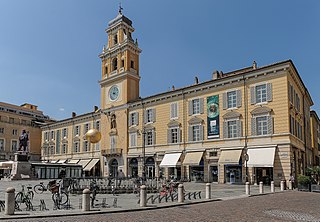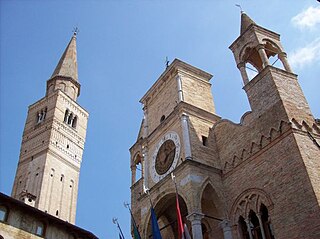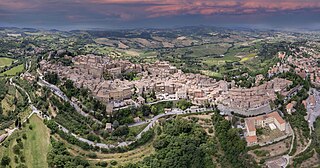
Parma is a city in the northern Italian region of Emilia-Romagna known for its architecture, music, art, prosciutto (ham), cheese and surrounding countryside. With a population of 198,292 inhabitants, Parma is the second most populous city in Emilia-Romagna after Bologna, the region's capital. The city is home to the University of Parma, one of the oldest universities in the world. Parma is divided into two parts by the stream of the same name. The district on the west side of the river is Oltretorrente. Parma's Etruscan name was adapted by Romans to describe the round shield called Parma.

Giorgio Vasari was an Italian Renaissance painter, architect, art historian and biographer, who is best known for his work Lives of the Most Excellent Painters, Sculptors, and Architects, considered the ideological foundation of all art-historical writing, and still much cited in modern biographies of the many Italian Renaissance artists he covers, including Leonardo da Vinci and Michelangelo, although he is now regarded as including many factual errors, especially when covering artists from before he was born.

Todi is a town and comune (municipality) of the province of Perugia in central Italy. It is perched on a tall two-crested hill overlooking the east bank of the river Tiber, commanding distant views in every direction. It was founded in antiquity by the Umbri, at the border with Etruria; the gens Ulpia of Roman emperor Trajan came from Todi.

Palazzo Farnese or Farnese Palace is one of the most important High Renaissance palaces in Rome. Owned by the Italian Republic, it was given to the French government in 1936 for a period of 99 years, and currently serves as the French embassy in Italy.

The Villa Farnese, also known as Villa Caprarola, is a pentagonal mansion in the town of Caprarola in the province of Viterbo, Northern Lazio, Italy, approximately 50 kilometres (31 mi) north-west of Rome, originally commissioned and owned by the House of Farnese. A property of the Republic of Italy, Villa Farnese is run by the Polo Museale del Lazio. This villa is not to be confused with two similarly-named properties of the family, the Palazzo Farnese and the Villa Farnesina, both in Rome.

GiacomoBarozzida Vignola, often simply called Vignola, was one of the great Italian architects of 16th century Mannerism. His two great masterpieces are the Villa Farnese at Caprarola and the Jesuits' Church of the Gesù in Rome. The three architects who spread the Italian Renaissance style throughout Western Europe are Vignola, Serlio and Palladio. He is often considered the most important architect in Rome in the Mannerist era.

The Church of the Gesù is the mother church of the Society of Jesus (Jesuits), a Catholic religious order. Officially named Chiesa del Santissimo Nome di Gesù, its façade is "the first truly baroque façade", introducing the baroque style into architecture. The church served as a model for innumerable Jesuit churches all over the world, especially in Central Europe and in Portuguese colonies. Its paintings in the nave, crossing, and side chapels became models for art in Jesuit churches throughout Italy and Europe, as well as those of other orders. The Church of the Gesù is located at the Piazza del Gesù in Rome, and is one of the great 17th century preaching churches built by Counter-Reformation orders like the Jesuits in the Centro Storico.

Pordenone is a city and comune (municipality) in the Italian region of Friuli-Venezia Giulia, the capital of the Regional decentralization entity of Pordenone.

Montepulciano is a medieval and Renaissance hill town and comune in the Italian province of Siena in southern Tuscany. It sits high on a 605-metre (1,985 ft) limestone ridge, 13 kilometres (8 mi) east of Pienza, 70 kilometres (43 mi) southeast of Siena, 124 kilometres (77 mi) southeast of Florence, and 186 kilometres (116 mi) north of Rome by car.

The Basilica of San Petronio is a minor basilica and church of the Archdiocese of Bologna located in Bologna, Emilia Romagna, northern Italy. It dominates Piazza Maggiore. The basilica is dedicated to the patron saint of the city, Saint Petronius, who was the bishop of Bologna in the fifth century. Construction began in 1390 and its main facade has remained unfinished since. The building was transferred from the city to the diocese in 1929; the basilica was finally consecrated in 1954. It has been the seat of the relics of Bologna's patron saint only since 2000; until then they were preserved in the Santo Stefano church of Bologna.

Castiglione del Lago is a town in the province of Perugia of Umbria, on the southwest corner of Lake Trasimeno. Orvieto is 59 km (37 mi) south, Chiusi is 21 km (13 mi) to the south west, Arezzo is 56 km (35 mi) to the north west, Cortona is 21 km (13 mi) to the north and Perugia is 47 km (29 mi) to the south east.

Marcantonio Franceschini was an Italian painter of the Baroque period, active mostly in his native Bologna. He was the father and teacher of Giacomo Franceschini.

Palazzo Farnese is a palace in Piacenza, northern Italy.

Formigine is a town and comune in the province of Modena, Emilia-Romagna, Italy. As of 2023, Formigine had an estimated population of 34,406.

Oriolo Romano is a comune (municipality) in the Province of Viterbo in the Italian region of Latium, located about 40 kilometres (25 mi) northwest of Rome and about 30 kilometres (19 mi) south of Viterbo on a hilly area near the ancient Via Clodia.
The Palazzo Bocchi is a Renaissance style palace located on Via Goito 16 in central Bologna, region of Emilia-Romagna, Italy.

Giacomo Boncompagni was an Italian feudal lord of the 16th century, the illegitimate son of Pope Gregory XIII. He was also Duke of Sora, Aquino, Arce and Arpino, and Marquess of Vignola.

The Basilica of San Giacomo Maggiore is an historic Roman Catholic church in Bologna, region of Emilia Romagna, Italy, serving a monastery of Augustinian friars. It was built starting in 1267 and houses, among the rest, the Bentivoglio Chapel, featuring numerous Renaissance artworks.
Palazzo Zani is a Renaissance palace on via Santo Stefano 56 in central Bologna, region of Emilia Romagna, Italy.




















